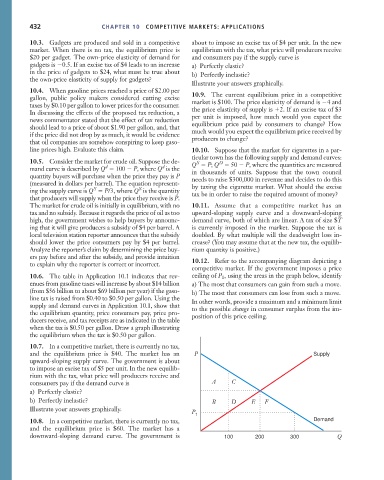Page 458 - Microeconomics, Fourth Edition
P. 458
c10competitive markets applications.qxd 7/15/10 4:58 PM Page 432
432 CHAPTER 10 COMPETITIVE MARKETS: APPLICATIONS
10.3. Gadgets are produced and sold in a competitive about to impose an excise tax of $4 per unit. In the new
market. When there is no tax, the equilibrium price is equilibrium with the tax, what price will producers receive
$20 per gadget. The own-price elasticity of demand for and consumers pay if the supply curve is
gadgets is 0.5. If an excise tax of $4 leads to an increase a) Perfectly elastic?
in the price of gadgets to $24, what must be true about b) Perfectly inelastic?
the own-price elasticity of supply for gadgets?
Illustrate your answers graphically.
10.4. When gasoline prices reached a price of $2.00 per
gallon, public policy makers considered cutting excise 10.9. The current equilibrium price in a competitive
taxes by $0.10 per gallon to lower prices for the consumer. market is $100. The price elasticity of demand is 4 and
In discussing the effects of the proposed tax reduction, a the price elasticity of supply is 2. If an excise tax of $3
news commentator stated that the effect of tax reduction per unit is imposed, how much would you expect the
should lead to a price of about $1.90 per gallon, and, that equilibrium price paid by consumers to change? How
if the price did not drop by as much, it would be evidence much would you expect the equilibrium price received by
that oil companies are somehow conspiring to keep gaso- producers to change?
line prices high. Evaluate this claim. 10.10. Suppose that the market for cigarettes in a par-
ticular town has the following supply and demand curves:
10.5. Consider the market for crude oil. Suppose the de- Q P; Q 50 P, where the quantities are measured
S
D
d
d
mand curve is described by Q 100 P, where Q is the in thousands of units. Suppose that the town council
quantity buyers will purchase when the price they pay is P needs to raise $300,000 in revenue and decides to do this
(measured in dollars per barrel). The equation represent- by taxing the cigarette market. What should the excise
S
S
ing the supply curve is Q P/3, where Q is the quantity tax be in order to raise the required amount of money?
that producers will supply when the price they receive is P.
The market for crude oil is initially in equilibrium, with no 10.11. Assume that a competitive market has an
tax and no subsidy. Because it regards the price of oil as too upward-sloping supply curve and a downward-sloping
high, the government wishes to help buyers by announc- demand curve, both of which are linear. A tax of size $T
ing that it will give producers a subsidy of $4 per barrel. A is currently imposed in the market. Suppose the tax is
local television station reporter announces that the subsidy doubled. By what multiple will the deadweight loss in-
should lower the price consumers pay by $4 per barrel. crease? (You may assume that at the new tax, the equilib-
Analyze the reporter’s claim by determining the price buy- rium quantity is positive.)
ers pay before and after the subsidy, and provide intuition
to explain why the reporter is correct or incorrect. 10.12. Refer to the accompanying diagram depicting a
competitive market. If the government imposes a price
10.6. The table in Application 10.1 indicates that rev- ceiling of P 1 , using the areas in the graph below, identify
enues from gasoline taxes will increase by about $14 billion a) The most that consumers can gain from such a move.
(from $56 billion to about $69 billion per year) if the gaso- b) The most that consumers can lose from such a move.
line tax is raised from $0.40 to $0.50 per gallon. Using the In other words, provide a maximum and a minimum limit
supply and demand curves in Application 10.1, show that to the possible change in consumer surplus from the im-
the equilibrium quantity, price consumers pay, price pro- position of this price ceiling.
ducers receive, and tax receipts are as indicated in the table
when the tax is $0.50 per gallon. Draw a graph illustrating
the equilibrium when the tax is $0.50 per gallon.
10.7. In a competitive market, there is currently no tax,
and the equilibrium price is $40. The market has an P Supply
upward-sloping supply curve. The government is about
to impose an excise tax of $5 per unit. In the new equilib-
rium with the tax, what price will producers receive and
consumers pay if the demand curve is A C
a) Perfectly elastic?
b) Perfectly inelastic?
B D E F
Illustrate your answers graphically.
P 1
10.8. In a competitive market, there is currently no tax, Demand
and the equilibrium price is $60. The market has a
downward-sloping demand curve. The government is 100 200 300 Q

